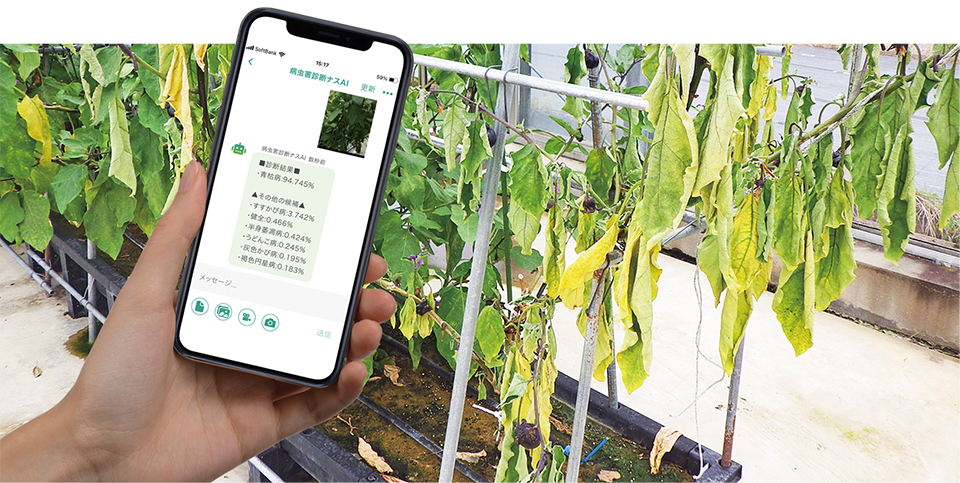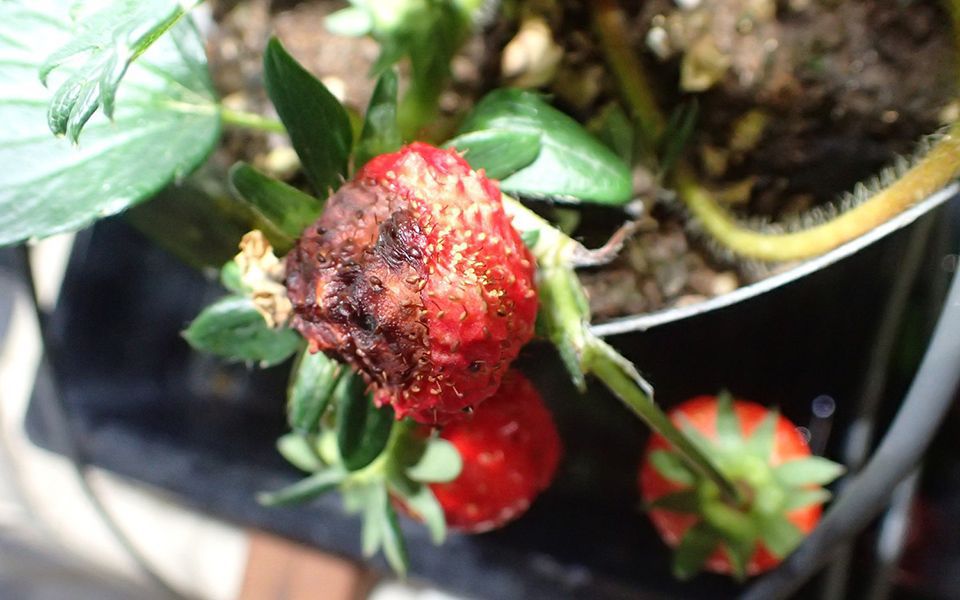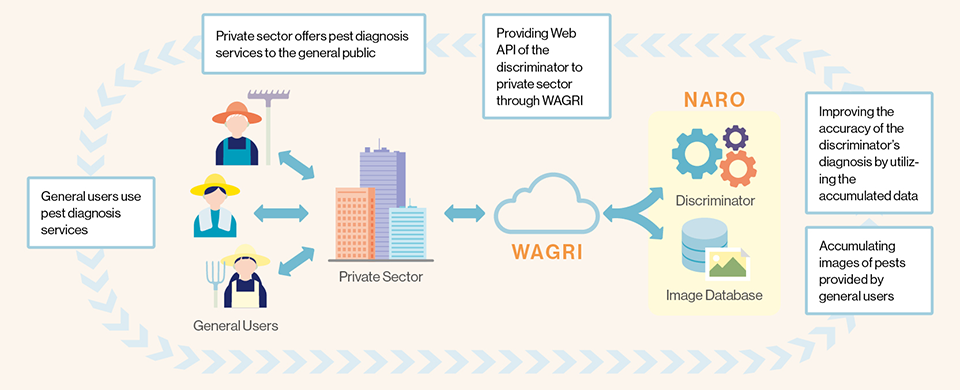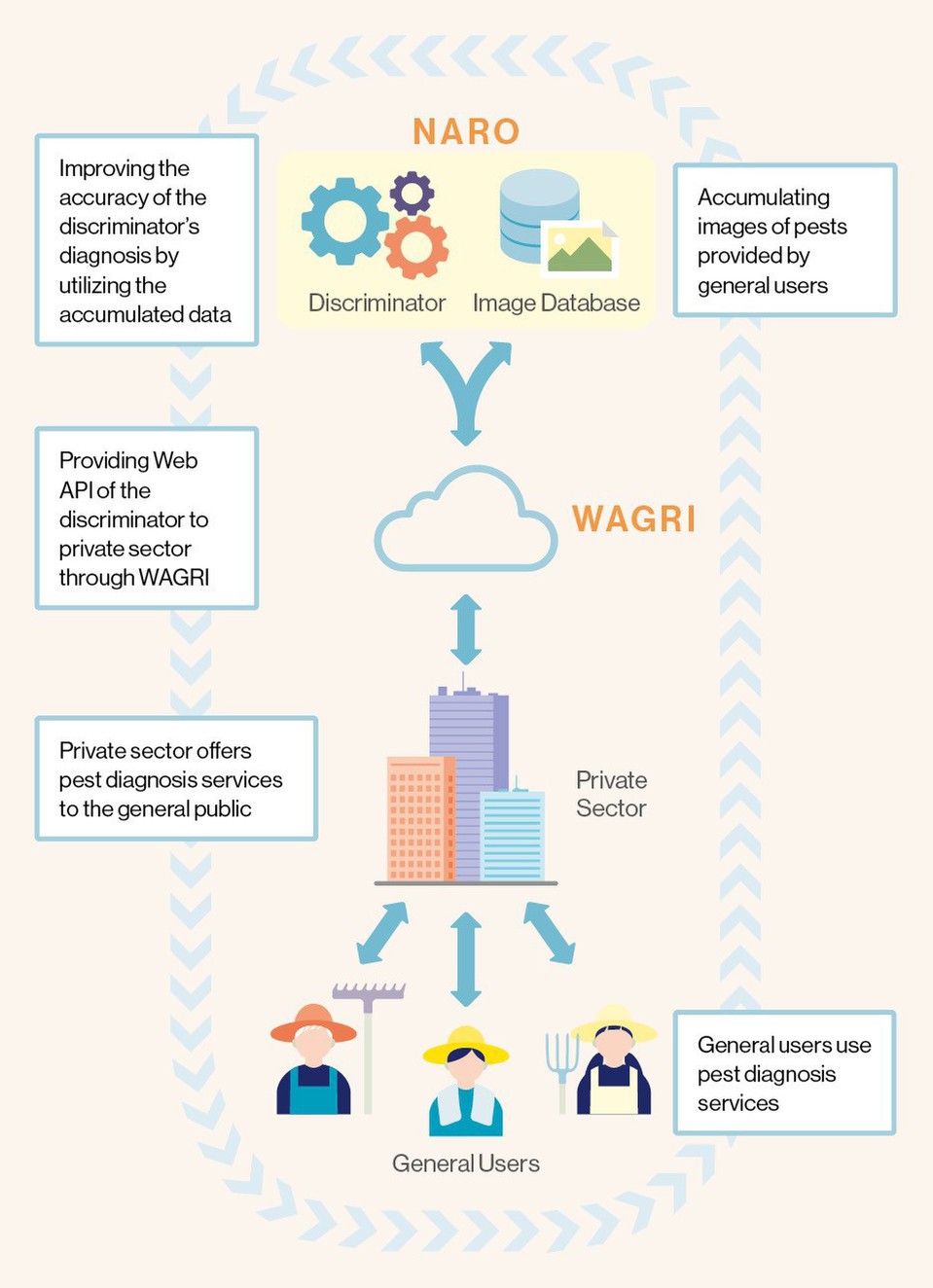Artificial intelligence, or AI, has made rapid gains in recent years as it approaches the level of human intelligence. The Government of Japan has formulated a national strategy that is accelerating efforts to apply AI to real life. One example of the high-level AI social implementation pioneered by Japan is agricultural pest diagnosis using AI—part of a smart agriculture drive.

FarmChat is an agricultural ICT app offered by Farm Alliance Management. It uses the AI pest identification system developed by the NARO-led consortium. The user sends a photo of the produce damaged by a pest, which FarmChat uses to determine the disease and the harmful insect. An increasing number of farms are using the app. CREATED USING AN IMAGE TAKEN FROM THE AI PEST IMAGE DB (https://www.naro.affrc.go.jp/org/niaes/damage)
“AI will surpass human intelligence.” Such a comment is a sign of how remarkable AI’s recent progress has been. The Government of Japan considers AI a core part of its growth strategy in seeking to achieve a new form of capitalism as proposed by the Kishida administration. Since 2019, a national strategy has been in motion to conduct R&D and implement AI in society. Under the AI Strategy 2022 announced this April, Japan aims to create Society 5.0—the next logical step in the progression from a hunter-gatherer society through an agricultural society, industrial society, and the information society of today—which will achieve advanced convergence between cyberspace and physical space. In order to take that step, the AI strategy sets new goals to make AI a more entrenched part of society and creates a concrete action plan to respond to emerging threats and challenges facing society, such as pandemics and major disasters.
With the support of that strategy and the Public/Private R&D Investment Strategic Expansion PrograM (PRISM), a national government initiative to create scientific and technological innovation, the implementation of AI has led to a notable evolution in agriculture. Japan’s temperate and wet climate is also unfortunately conducive to a wide variety of pests. Indeed, those plants and animals designated as harmful species by the government, and thus controlled through a pest forecasting project, total some 110 species of insects, pathogens, and so forth. Subduing these menaces requires their prompt identification, followed by appropriate countermeasures. In recent years, however, Japan’s aging farming population and the increase in the number of new farmers and farming organizations has led to greater difficulty in the smooth transmission of techniques for pest diagnosis and pest control. It has been noted that global warming and abnormal weather patterns may lead to an increase in the pest population, as well as changes in when and where they appear. That means conventional knowledge may be insufficient to cope with controlling these pests.
In response, a consortium led by the National Agriculture and Food Research Organization (NARO) has developed a sophisticated system using AI to identify images of agricultural pests. This will enable relatively inexperienced farmers to quickly and accurately identify pests. The system is expected to be part of a smart agriculture approach that uses fewer agricultural chemicals and makes farming more efficient.

Examples of pests identifiable with a system developed by a NARO-led consortium. Photo shows crown rot of a strawberry. AI PEST IMAGE DB (https://www.naro.affrc.go.jp/org/niaes/damage)
Similar systems are under development around the world, but the NARO-led consortium says its system is superior in terms of the quality and quantity of data used to train the AI. Working with public research organizations in 24 Japanese prefectures, the consortium has gathered approximately 700,000 images of pests that experts have tagged with accurate labels. Furthermore, the consortium has collaborated with universities and system development firms with AI knowledge to recognize images more accurately by removing backgrounds and detecting objects with a convolutional neural network, a deep learning method modeled on the human visual cortex. The result is a system that can recognize major pests of four crops—tomatoes, cucumbers, strawberries, and eggplants—with more than 80% accuracy.

Examples of pests identifiable with a system developed by a NARO-led consortium. Photo shows crown rot of a strawberry. AI PEST IMAGE DB (https://www.naro.affrc.go.jp/org/niaes/damage)
Challenges arose when putting the system into practice. YAMANAKA Takehiko from NARO said, “We’re a research institute, so developing commercial services is not within our expertise.” NARO decided to use a cloud service, the WAGRI agricultural data collaboration platform, to release this AI diagnosis system as a web Application Programming Interface (API) in 2021. It provides private enterprises with affordable access to the system so as to develop their own AI pest-diagnosis apps. As a result, the technology has quickly been accepted in practical agricultural fields. This year, eight more crops were added to the system. Next, the consortium plans to create a data aggregation scheme to train AI with data collected from general users to further bolster the system’s accuracy. The system will also gain a feature to provide information on both the ecology and control methods for identified pests. The consortium has received inquiries from private businesses about rolling out the system in other countries and may consider localizing it in the future.
People program AI and AI helps mankind. Through this cycle, humanity and AI will grow together, which will turn Japan into a scientific and technological powerhouse. The fruits of the growth reaped by AI will be enormous.
A growth model of the AI-powered pest identification system




